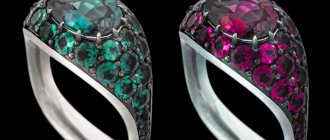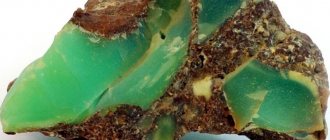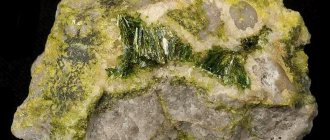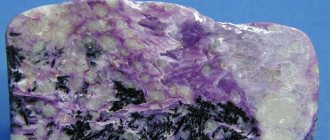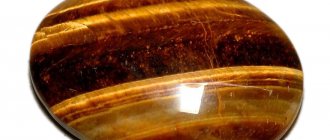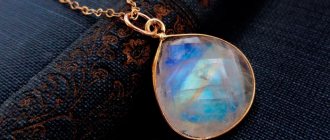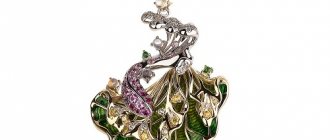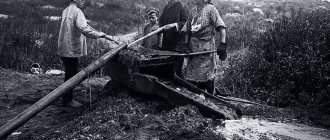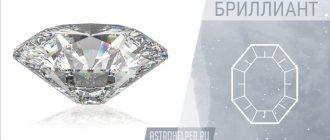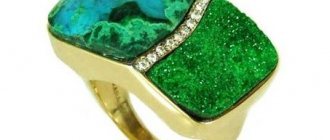- Which: Precious;
- Deposits: Labrador Peninsula (Canada), USA, Mexico, Finland, India, Madagscar, Ukraine;
- Colors: Gray to almost black with multi-colored tints;
- Mohs hardness: 6-6.5;
- Transparency: Opaque;
- Density: 2.7 g/cm³;
- Formula: (Ca, Na)[(Al, Si)AlSi2O8];
- Who is suitable according to their zodiac sign: Everyone, but there are rules;
- How much does it cost: from 5 dollars.
Labradorite is a gemstone that is obtained from the mineral of the same name through special processing. The colors of Labradors can be blue, purple and dark green.
Its main secret is a beautiful iridescent glow in bright light (scientists call this effect iridescence).
Labradorite stone goes well with almost any clothing, and some people believe that it has healing and magical properties.
Origin story
According to legend, the Hyperboreans were the first to use Labradorite. In the era of antiquity and the Middle Ages, the labradorite stone was practically unknown (although there were many legends about the mysterious jewels of the East).
However, in 1770, large deposits were discovered on the Labrador Peninsula, which is located in modern Canada, and the gem itself became very popular in Europe.
Also, small deposits were discovered in Russia, after which they began to make jewelry, snuff boxes, and so on from Labradorite stone.
Labradorite - a mysterious stone from legend
In 1770, extravagant Europe, during the heyday of the Rococo era, captivated people with an unusual stone brought from North America from the Labrador Peninsula. The stone became very fashionable among aristocrats, the richest people of that time, as well as among all kinds of magicians and psychics. It was believed to have miraculous properties. Labradorite, as this miraculous mineral was later named, attracted attention with its bright rainbow tints. Now we call this effect iridescence. The reason for its appearance remained a mystery for a long time. Only studies using an electron microscope made it possible to find out that Labradorite consists of the thinnest plates, slightly different in composition. The interaction of light waves reflected from different plates leads to the appearance of bright, spectrally pure colors.
In those distant times, they wore a lot of jewelry and with pleasure. They embroidered men's and women's clothing, decorated fans and snuff boxes. An object unfamiliar to us - a flea trap box, in beautiful ornaments, was also strewn with diamonds and all kinds of precious stones. Yes, I must admit, they didn’t like to wash in Europe. At court they often scratched themselves and smelled strongly of perfume. Why the French invented perfume, one can only guess.
Flea trap box, 18th century.
That's how they wore it.
The flea trap box could have very bizarre shapes...
(Sorry for going off topic.)
Labradors with blue, purple, yellow and green tints were inserted into rings, brooches, and earrings. Bracelets and necklaces (chokers) were made with these stones. A properly processed stone was mesmerizing, flashing with bright colors when the light hit its surface.
Labradorite is a calcium-sodium plagioclase feldspar, intermediate in composition between albite Na [AlSi3O8] and anorthite Ca [Ai2Si2O8]. A rock composed predominantly of this mineral is called labradorite. Hardness on the Mohs scale is 6, which is quite enough to use the stone for ornamental work. The average specific gravity is 2.7 g/cm3, density is 2.69-2.70 g/cm3. It contains 3.96% magnesium oxide, 10.93% calcium oxide, 26.83% aluminum oxide and 55.49% silicon oxide. Iron, potassium and magnesium are characteristic impurities. Labradorite formations are represented by dense, coarse-crystalline masses. Sometimes small crystals are found. having a prismatic structure. Labradorite is a mineral of igneous origin. Formed in basalt voids. The mineral's satellites are magnetite, olivine, pyroxene, and pyrrhotite.
All known types of labradorites can be divided into:
1. Spectrolite - shimmers with all the colors of the rainbow.
2. Black moonstone is a dark-colored mineral with blue or light blue iridescence.
3. Sunstone - light orange with golden iridescence. Found only in the USA, Oregon.
4. Bull's eye - shimmers with red-brown shades, the stone itself is violet-brown.
5. Lynx eye - differs from a bull eye in its characteristic green reflection.
6. Aventurine Labradorite - golden shimmer. The presence of copper and magnetite creates a shimmering effect.
7. Tavusit - can be compared to the shimmer of peacock feathers.
A few years later, after Europe became acquainted with the new mineral, in Russia, in the fall of 1781, under granite fragments that were used to improve the road from St. Petersburg to the royal pleasure palace in Peterhof, a significant mass, almost entirely consisting of feldspar, was found to North American raw labradorite stone. It was the construction of the road that helped discover the stone on the territory of our country and this was the first deposit in Europe. The news that an overseas gem was lying right on the road near the Russian capital created a sensation.
In the famous book of 1789 “The First Foundations of Mineralogy”, author V.M. Severgin describes the find this way: “Labrador, blueberry, iris. The color is always almost light gray, dark gray, black-gray, but in different directions it mostly shines with very bright variegated colors, such as azure, blue, different shades of green, sometimes lemon, and a color that is in the middle between copper and tambaco, and sometimes issera-violet...rarely do these flowers extend over the entire piece, but are usually visible only in places..."
After the discovery of the deposit, there was a new round of popularity and increased interest in Labrador. He began to be present wherever possible. The ladies of the court wore all kinds of jewelry and even dresses that resembled him in color. The stone was widely used for finishing and decorating palaces. Interior items were made from labradorite: snuff boxes, tabletops, inkwells, vases and other things dear to the heart.
The eyes sparkling with all shades of peacock feathers seem to be inlaid into dark rock. Moreover, these overflows appear only with proper processing and skillful polishing. Sometimes, flashes of color can be seen on a wet stone. If you twirl a polished piece of labradorite in your hands, some eyes will flash and others will go out. Sometimes on a labradorite slab measuring 1 square meter, you can count 200-300 iridescent eyes. Successfully crafted eyes could cost more than diamonds. Let’s say an insert for a ring in the capital could cost from 25 to 100 rubles, a snuff box from 500 to 1500 rubles.
In the 19th century, another rich deposit was found on the territory of Ukraine. In 1835, the world's richest deposits of labradorite, or as it was called in Russia, “ peacock stone,” . It turned out that entire rock masses not far from Zhitomir are composed of fashionable and expensive gemstones. They occupy an area of up to 1000 square meters. km. There are places in the Zhytomyr region where the beauty of stone is available to everyone. The small river Irsha in some places polished the stone so that blue-green sparks are visible in the black rocks from afar.
Currently, labradorite is mined in Yakutia, Buryatia, Krasnodar and Khabarovsk territories. Mining is still underway in eastern Canada - the Labrador Peninsula and the Greenville Mines. Single deposits have been found in Finland, India, Greenland, and Tibet. Rare gem-quality minerals are mined in Australia. Spectrolites are found in only one place on earth: the vicinity of the Finnish city of Ylämaa.
It is interesting that the “peacock stone” survived oblivion on our land, and more than once. How and why they completely forgot about him is unknown. Our distant ancestors from the times of Kievan Rus used it in architecture. Its blue crystals were used in mosaics for the interior decoration of churches. The excess stone was sold to the East, where it was called tausin (from the Arabic word “taus” - peacock).
The discovery of a deposit in Ukraine has greatly reduced the price of Labradorite. From a precious stone it has turned into a fairly affordable finishing material. It can be seen on city streets in the lining of fountains and columns. But this does not at all detract from its merits and beauty. Labrador has a very ancient history and its connection with the ancient peoples who inhabited our planet is very long.
A number of scientists and archaeologists have been trying to find the ancestral home of humanity for several decades. In Yakutia, back in the 80s of the 19th century, excavations were carried out on the territory of the Lena Pillars natural park and sensational archaeological discoveries were made.
Lena Pillars National Park is one of the natural wonders of Yakutia.
The reserve covers an area of about 500 hectares.
The Lena Pillars reserve is included in the UNESCO heritage list.
Along the banks of the Lena River, relict rocks stretch for tens of kilometers.
These regions can tell a lot about the history of mankind. In 1982, archaeologist Yuri Molchanov discovered the ancient site of Diring Yuryakh in the park.
The age of the finds is determined by scientists in the range from 3 to 2 million years. This fully confirms the version of a number of modern scientists that one of the centers of the origin of humanity was located in the northern territories of what is now Russia. Which forces the scientific world to seriously reconsider the concept of the origin of humanity in East Africa. Already in August 1988, the All-Union Conference “The Problem of the Ancient Homeland of Humanity in the Light of New Archaeological Discoveries” was held there in Yakutia. The scientists' conclusion was clear. Research is not only a national, but also a universal, planetary asset. The very presence of this focus of protoculture is consistent with geological data on the existence of a large continent in the area of the current north pole. As well as the Avestan and Vedic epics, according to which there was an ancient paracivilization in the North that sank to the bottom of the Arctic Ocean as a result of a global natural disaster.
The word “Hyperborea” was first mentioned in the works of ancient Greek researchers. From the ancient Greek Hyperborea is translated as “beyond Boreas,” beyond the north wind. Pliny the Elder wrote about the Hyperboreans as a real people, without any mythological background. The map of the famous 16th century cartographer Gerardus Mercator (1512-1594), where he allegedly first showed Hyperborea in the North Pole region, created a lot of noise in scientific circles and continues to excite the minds of researchers to this day.
Blavatsky and the Roerichs, as well as other esotericists, including the ideologists of the Annenerbe, later wrote about ancient Hyperborea. They all agreed that Hyperborea was one of the most ancient civilizations on Earth, if not the most ancient. The descendants of which later populated the territories of the Urals, Siberia and Northern Europe. Nostradamus, in his “Centuries,” called the Russian people Hyperborean. There is no doubt that ancient Hyperborea is directly related to the history of Russia.
According to one legend, it was the Hyperboreans who first discovered and appreciated the stones that are now familiar to us under the name Labradorite. They valued this stone not only for its unexpected splashes of color and deep shades, appearing as if from within the mineral itself, but also for properties about which we know little. It is believed that the Hyperboreans had abilities and knowledge about which our civilization today has no idea. They lived in harmony with nature, knew its characteristics, understood its laws and felt the inextricable connection of times. The stone with blue-green tints was a friend and assistant in all matters for the inhabitants of Hyperborea. They agreed with him, they listened to him, he was held in special esteem among other stones and objects. This was no ordinary stone. He had his own character and not everyone could have it. The Hyperboreans themselves, in order to test a person, could give him jewelry with a stone that was impossible to refuse. And the stone decided to accept the person as its owner, or to reject it. If a person had good qualities - the stone was devoted to him and directed him on the right path, he could adjust the owner’s thinking in such a way that he himself found a solution from a seemingly hopeless situation. Immoral and weak people could not stand the test of the stone; it could even harm them.
Labradorite stones are usually divided by gender into male and female. Men's stones include light, golden shades, while women's stones are darker green and blue. A pair of such opposite-sex stones attracts marital happiness and prosperity to the home. These can be uncut stones, stone figurines or decoration. There is an opinion among astrologers that the Labrador, as a watchdog, will not allow a stranger with bad intentions to enter the house and will ward off trouble.
This cute dog of the Labrador breed, with the stone, except for the name of the breed, nothing connects him, well, maybe only devotion and loyalty to the person. You need to tame him, make friends with him and accept him into your family. And the same with stone. Then he will serve you faithfully.
If you learned something new and the article seemed useful to you, click “like” and “add to favorites.”
Thank you for your attention.
Best wishes!
Main varieties
There are the following types of Labrador:
Black lunar
This variety has a characteristic blue or bluish sheen in bright light. It is widely used in jewelry, and most jewelry is made from stones of this type.
Solar
It is mined in the USA, and its characteristic feature is its bright yellowish-golden and even white color.
Spectrolite
In the light it shimmers with all the colors of the rainbow. This type of stone was discovered in 1940, and the production of jewelry with spectrolites began after World War II.
Color and varieties of mineral
The properties of Labradorite stone are dictated by its chemical composition. It belongs to the feldspars. Its formula contains mainly alkali metals - sodium and calcium with inclusions of aluminum. The ratio of various elements in each specimen determines its color.
Due to its structure, moonstone boasts iridescence - the play of light rays on the surface. This characteristic is truly irreplaceable in design, because it allows you to achieve incredibly beautiful effects.
There are many types of Labrador retriever nowadays:
- Tawusin, or peacock stone, known in the Middle East. This is a rainbow crystal with incredible beauty of tints and reflections. In each specimen you can see many shades of color, which is why the gem got its name.
- Sunstone is a unique crystal with a bright golden color. In India, it was considered a “female” gem, capable of bringing happiness to the fair sex.
- Bull's eye is a subspecies of the mineral that shimmers in all shades of red, crimson, sometimes interspersed with purple and red.
- Black Moon Labradorite is a stone the color of the night sky with dark blue iridescence. This is what is mined on the island of Madagascar. The variety of sizes and shapes in which it is presented here is truly inexhaustible. Each specimen is unique in its own way.
- Spectrolite is a gem mined in Finland. This stone, which resembles a peacock's eye, was discovered by chance in the Land of a Thousand Lakes during World War II. When it ended, the largest geologists from Europe and the USSR began exploring the deposits. In each such specimen you can see all the colors of the rainbow.
- Lynx eye is a bright green mineral that sparkles in the twilight. Found in the Urals.
All crystals, regardless of color, have almost identical magical and healing properties. Therefore, you can choose a suitable decoration with Labradorite based only on your ideas about good taste.
Labradorite or labradorite?
Labradorite
In many European countries, labradorite is called labradorite. This often leads to confusion because labradorite is also a name for an igneous rock that is somewhat similar in appearance and some physical properties to labradorite.
Here you need to understand that labradorite differs from labradorite in composition, physical and medicinal properties, therefore it is wrong to equate these minerals.
Spectrolite and labradorite: meaning
The meanings behind spectrolite and labradorite are rooted in their iridescence. Their dark surface with shining rays of color mainly symbolizes protection and transformation.
Labradorite is a stone of protection and wisdom. Primarily associated with the mind, many use labradorite to increase their level of self-awareness or reduce their self-doubt. This stone is believed to protect against negativity, both internal and external.
Spectrolite is endowed with more mystical properties. The stone symbolizes healing and transformation, but these do not actually come from the stone itself. It is believed that spectrolite helps to find answers within oneself. One way to do this is to make you feel more confident in your intelligence by inspiring original ideas or solutions. Another way is to identify any existing psychic powers, such as clairvoyance or prophetic dreams.
Physical properties
Labradorite stone has the following physical characteristics:
- Consists of 50-70% CaAl2Si2O8 and 30-50% NaAlSi3O8. May contain small impurities of iron, manganese and magnesium.
- Color - dark gray, smoky gray and completely black. In the light it has characteristic blue, cyan, blue-green and multi-colored iridescence (depending on the stone) due to a phenomenon called iridescence. It should be remembered that iridescence appears only after polishing, and untreated Labradorite stone looks uninteresting and does not shine.
- Opaque,
- Does not luminesce.
- Soluble in acids.
- It crumbles and is easily crushed upon impact.
- It has a triclinic system.
- Density is about 2.7 grams per cubic centimeter.
- Hardness – 6 – 6.5 units on the Mohs scale.
- The average crystal size is about 5-10 centimeters; crystals larger than 50 centimeters are extremely rare.
Physico-chemical characteristics
Labradorite is a silicate. According to the IMA classification, a mineral and a solid solution at the same time.
The labradorization effect is due to cleavage and impurities.
| Acidity | SiO2 45-52% |
| Color | gray, brownish or almost black |
| Texture | massive |
| Density | 2,7 |
| Form of occurrence | laccoliths, lopoliths, dikes, stocks |
| Separateness | layered, parallelepipedal |
| Genesis | intrusive rock |
| Type | Igneous |
| Class | Plutonic |
| Squad | Basic |
| Suborder | Normal alkaline |
| Family | Gabbroids |
| View | Anorthosite |
| Variety | Labradorite |
| Main (typomorphic) minerals | Basic plagioclase (labradorite) |
Magical and healing properties
Labradorite has the following healing properties:
- Helps with infertility, impotence and some other diseases of the genitourinary system.
- Relieves pain in joints and spine.
- Relieves headaches and can slightly reduce the temperature of a cold (by 0.3 - 0.6 degrees).
- Can be used to prevent cancer, diseases of the throat, lungs and mouth.
- Helps in the fight against kidney stones by stimulating metabolism.
- Normalizes sleep and relieves nervousness. It can also be used for the treatment of alcoholism and drug addiction as an additional therapy.
Labradorite stone also has magical properties:
- The meaning of this mineral is to protect homes from the penetration of both evil spirits and bandits (for a person who does not break the law, it does not pose a threat). For example, place a small labradorite under the doormat in front of the door - and then it will be extremely difficult for thieves to break into the door.
- Helps to anticipate events that will happen in the near future (2-7 days).
- Gives the owner eloquence, keen intuition and self-confidence.
- With its help, a businessman will be able to make more profitable purchases.
- It will allow ordinary people to avoid conflicts.
- Also, Labradorite is considered an adornment for young and beautiful girls. It is believed that with the help of the magic of labradorite you can charm your lover.
- It enhances extrasensory and parapsychological abilities, which is why people of creative professions love to wear it.
Name compatibility
Labradorite is an ideal talisman for a woman named Yana. The stone enhances her intellectual abilities and intuition, gives worldly wisdom, helps to recognize the true intentions and attitudes of others.
Despite the fact that the stone favors only one name, it can be safely worn by men and women with any name. When choosing an amulet, the compatibility of the Labrador with the character and zodiac sign of the owner is much more important.
Who is suitable according to their zodiac sign?
Can all zodiac signs wear Labradorite stone?
Let's find out who this mineral is suitable for:
- Capricorns, Aquarius and Cancers should wear Labrador with caution. The fact is that Labrador has great psychic potential, and these zodiac signs can control this element rather weakly. In other words, the Labradorite stone can do more harm to these zodiac signs than good.
- Aries, Taurus and Gemini according to the horoscope. Labradorite will give them self-confidence. Also, it will help restore mutual understanding in the family and strengthen the marriage. The mineral will give businessmen and creative people self-confidence, which can be useful in their business activities.
- Leo, Virgo, Libra can also wear Labradorite. It will give these zodiac signs confidence in the future, good mood and love for life. With its help, you can activate mental activity, which will help while studying.
- Scorpios, Sagittarius and Pisces should combine it with other jewelry as wearing a Labradorite by these zodiac signs has a weak astrological effect. For these zodiac signs, the stone will slightly enhance extrasensory abilities and cure minor illnesses, as well as slightly improve their mood.
Stone in esotericism and healing
Labradorite stone has been famous for its magical properties since ancient times. It is a very powerful amulet. When using a mineral as an amulet, a person has prophetic dreams.
It has long been believed that the mineral draws its strength from its owner. This means that the gem is able to improve the positive characteristics of its owner. At the same time, a person’s shortcomings will negatively affect him.
A Labrador worn by a positive person is able to take on the best from him. After which he transfers positive energy to the new owner. If you put a talisman under your pillow, it will help attract prophetic dreams. If the stone is near a stranger, it helps to see the future. Therefore, the gem functions as an amplifier and relay of its owner’s thoughts to the environment.
The magical properties of Labradorite allow it to be used as an amulet.
Since ancient times, magicians and sorcerers have used stone in various rites and rituals. This is due to the mystical properties of the gem:
- Labrador retriever has pronounced protective characteristics. The stone forms a barrier that negative energies cannot overcome to gain access to the personality's aura. By creating harmony between body and soul, the Labrador Retriever protects them.
- The stone has a calming effect on a person. It helps to neutralize experienced fears and remove negative memories. The mineral is able to reveal the abilities contained in everyone. As a result, one person becomes a psychic, and another discovers artistic talent.
- The mineral helps to regain lost faith in oneself. It gives its owner the ability to better understand their ideas, analyze information and develop inner consciousness.
- The gem makes its owner stronger and more resistant to stress. This helps him rethink the past and prepare the soul for subsequent development.
The crystal can activate the brain. This is especially true for students and people involved in science.
The healing characteristics of Labradorite and its importance for health have been known for a long time. Today, lithotherapists use the stone to treat the following disorders:
- sleep problems - these include nightmares, insomnia, restless sleep;
- cold;
- effects of stress;
- arterial hypertension;
- hernias;
- diseases of bone tissue, muscles and joints;
- severe PMS in women.
The talisman has a good effect on the condition of the entire body of its owner. It is able to have a general strengthening effect and improve working capacity. Therefore, the gem is often recommended to be worn by people who engage in heavy physical labor.
Systematically wearing jewelry with stones helps improve a person’s quality of life.
Massage therapists often use stone to knead tissue. With its help, it is possible to get rid of salt deposits, cope with pain, and make joints more mobile. The mineral also copes well with inflammatory processes in tissues. Cases of successful recovery from alcohol and drug addiction have been recorded.
Labradorite is often used in aurotherapy, which studies the effects of different colors on the human biofield. This gem shimmers in different shades of the rainbow.
Thanks to its amazing properties, the mineral is able to saturate the energy with radiation that a particular person lacks.
If you systematically wear jewelry with the lunar mineral, you will soon notice that your susceptibility to the influence of stress factors has decreased. The gem also helps cope with attacks of anger or apathy.
Jewelry with Labradorite is recommended to be worn by people who suffer from infertility, arthrosis, and osteochondrosis. The mineral is also suitable for diseases of the heart, blood vessels and genitourinary system. It is recommended for use in cases of a weakened immune system and in the presence of chronic inflammation.
When choosing jewelry with a stone, you need to focus on energy compatibility.
Application of Labradorite
Thanks to its unusual color and characteristic shine, Labradorite stone has found wide application in everyday life. There are two main uses - use as a precious item and use as a facing material.
Decorations
A large number of jewelry are made from Labradorite. These can be earrings, rings, beads, pendants, figurines and so on. Also, various magical pendants and amulets are made from it, with the help of which you can protect yourself from evil spirits and criminals.
When making jewelry, gold is usually not used - after all, the golden shine goes very poorly with the characteristic shine of the stone itself, and no one will buy such jewelry.
But silver and platinum are used very often - the whitish shine of precious metals resonates well not only with the stone itself, but also with its characteristic blue-green shine.
Other Applications
Labradorite is also used as a facing material. Wide thin tiles are made from it, which are then used to cover floors and wall surfaces.
For example, such cladding was very often used to decorate subway walls in Soviet times (at that time large deposits of this mineral were discovered in Ukraine).
However, today labradorite is used quite rarely as a facing material due to the high price of such tiles.
Where is the stone used?
Aesthetic and physical conditions determine the scope of application of Labradorite.
Decor
The characteristics of the stone are similar to granite. It is used in much the same way. The Mausoleum, the central staircase of the main Russian library (Leninki), metro stations, government buildings, banks, and other high-status institutions are decorated with Labrador.
Labradorite monuments are more expensive than granite ones, but they look more presentable.
Polished slabs of stone become countertops, premium-segment fireplace mantels, and cladding the plinths of houses.
Labradorite countertop
Labradorite jewelry
The most interesting specimens of labradorite are intended for jewelers.
However, it is difficult to work with:
- The fragile, fractured stone is framed in white gold or silver.
- More often they make small inserts of rings, earrings, pendants, and small beads for necklaces or bracelets. There are no size restrictions when it comes to Australian gems. The pendant and ring with this labradorite are very beautiful.
- The surface of the stone is polished with a cabochon: this is how the iridescence appears in all its glory.
Jewelry with labradorite Products
made from several varieties of labradorite are especially aesthetically pleasing.
Care and price
You need to care for the Labradorite stone as follows:
- Polish regularly with a soft, clean cloth or a special brush to keep it shiny.
- When processing, use only water. The use of detergents is prohibited - because they contain acids and alkalis, which can harm the stone.
- stored in a dry place.
- Labradorite tolerates high and low temperatures well, so there are no special recommendations regarding temperature conditions (although this does not mean that the stone can be stored in the cold or heated in an oven).
Labrador is not too expensive. A small pebble will cost only 5-10 dollars. The price of a good piece of jewelry for a woman will be about 50-60 dollars.
The average price of a beautiful Labradorite figurine will be about $100. Also, you need to understand that the markup in most stores is very large, so Labrador can cost even more.
Terms of use
Labradorite is fragile, so it is strengthened from cracking.
But you need to take care of it carefully:
- The box and products are protected from sudden temperature fluctuations.
- Before homework, the bracelet, ring, and ring with labradorite are removed.
- Dirt is removed with warm water and a soft cloth, without the use of active household chemicals.
Earrings, a brooch or a pendant with a stone are especially impressive in the sun, but in hot weather for a long time or on the beach it is better not to wear them.
What stones does it go with?
Combination with beryl
Combination with rose quartz
Combination with jade
- Pairs well with rose quartz, beryl, jade, moonstone and opal.
- Does not go well with amber, obsidian, malachite and sardonyx.
- Does not go well with emerald, topaz, zircon, peridot and aventurine.
How to distinguish from a fake?
You can find fake Labrador retrievers on sale. Also, some sellers offer for sale stones of unknown origin (most often rock crystal is used for this), calling them artificial Labradorite.
Here you need to understand the following - today there is no artificial Labradorite that would be indistinguishable in all characteristics from natural stone.
Therefore, it is stupid to buy such a stone - while some artificial stones very accurately reproduce natural stones, then artificial Labradorite is actually a cheap fake.
You can distinguish a real mineral from a fake like this:
- A real labradorite stone shimmers in the light with blue, blue-green and iridescent colors, while a fake does not have this effect.
- Also, you should ask the seller to provide a quality certificate that confirms the origin of Labradorite. If the jewelry seller refuses, then it makes sense to refuse the purchase.
We check the Labrador for authenticity
Fake Labradorite comes up on sale quite often. For example, some sellers sell specimens of unknown origin, passing them off as moonstones. In fact, it can be anything, even a piece of glass, even rock crystal.
Only natural Labradorite has magical properties.
Fortunately for buyers, it is impossible to create a counterfeit that is completely identical to the original in all properties. Therefore, a thorough check will always help bring fraudsters to clean water. You need to be especially careful if you plan to practice stone healing or magic, and that is why you are buying a Labradorite.
There are several ways to check whether the gem in front of you is real or a cheap counterfeit.
- Twist the Labradorite in the light, peering into the depths of the stone. It will shimmer in different colors and shades. It is very difficult to counterfeit iridescence, so scammers never do this. The copy in which the shades play is genuine.
- Press the stone against your body. Minerals have low thermal conductivity and will not heat up from your heat. Plastic or glass will warm up instantly.
- Carefully study the product data sheet. If it is not there at all, it is better to refuse the purchase. On fakes, they sometimes put the name of the imitation stone in quotation marks, or write something like “synthetic” in small, barely noticeable letters. This is a way to get rid of accusations of fraud on the part of the inspection authorities - formally, they honestly wrote to you that this is a fake.
Interesting Facts
Labrador in silver
Let's learn some interesting facts about Labrador:
- Lithotherapists believe that Labradorite can somehow accumulate the energy of the Moon. Therefore, during the full moon, it must be placed in an open place to recharge.
- In Kyiv, at the end of the 10th century, the Church of the Tithes was built, which was decorated with small fragments of labradorite. Scientists still do not know where these stones were mined.
- Seven centuries ago, it was believed that every wealthy Indian woman should have a Labradorite bracelet.
- At the end of the 18th century, a small Labrador retriever found in Russia was sold for huge sums of money. The uniqueness of the stone was that its shape is very similar to the profile of the famous French king Louis XIV.
- It is believed that Labrador owners can sometimes dream about things.
Stone care
If all minerals are afraid of direct sunlight, then Labrador is an exception. Not only is he not afraid of them, but he also has a positive attitude towards their radiance. Everyone knows that a gem is “recharged” by the energy of the Moon and the Sun, so it is recommended to allocate a place for storage so that, on the one hand, it is not particularly noticeable to strangers, and on the other, it can replenish its supply of solar and lunar energy.
As for the case, it should be separate and with a soft base. When cleaning, do not use detergents, especially those containing acids. You can lose your talisman forever.
